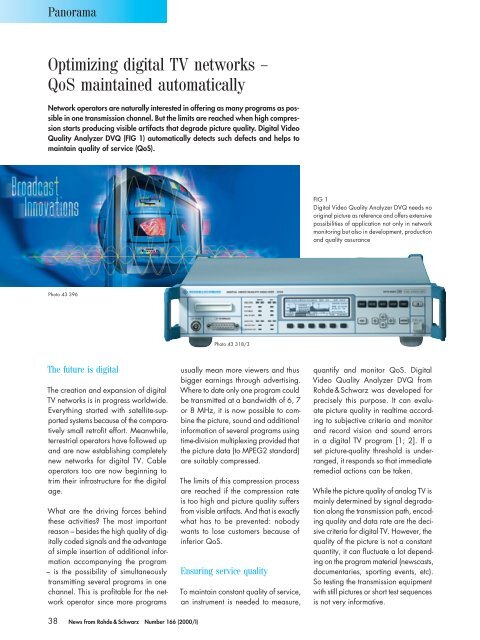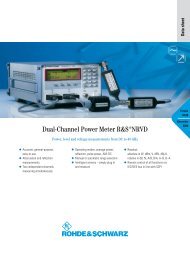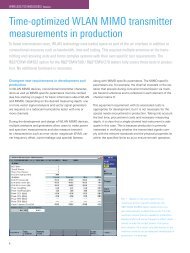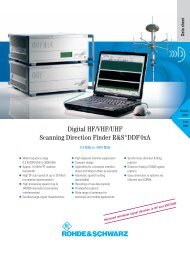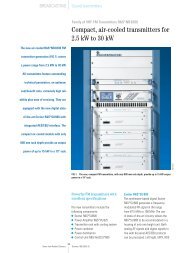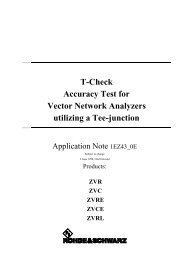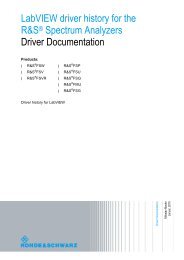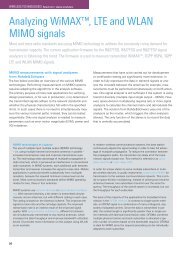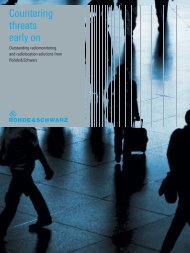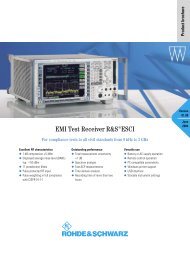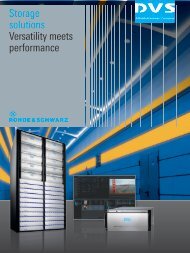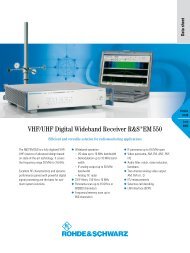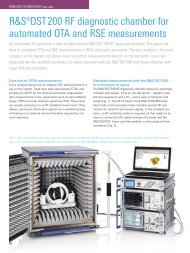English - Rohde & Schwarz
English - Rohde & Schwarz
English - Rohde & Schwarz
You also want an ePaper? Increase the reach of your titles
YUMPU automatically turns print PDFs into web optimized ePapers that Google loves.
Panorama<br />
Optimizing digital TV networks –<br />
QoS maintained automatically<br />
Network operators are naturally interested in offering as many programs as possible<br />
in one transmission channel. But the limits are reached when high compression<br />
starts producing visible artifacts that degrade picture quality. Digital Video<br />
Quality Analyzer DVQ (FIG 1) automatically detects such defects and helps to<br />
maintain quality of service (QoS).<br />
Photo 43 396<br />
The future is digital<br />
The creation and expansion of digital<br />
TV networks is in progress worldwide.<br />
Everything started with satellite-supported<br />
systems because of the comparatively<br />
small retrofi t effort. Meanwhile,<br />
terrestrial operators have followed up<br />
and are now establishing completely<br />
new networks for digital TV. Cable<br />
operators too are now beginning to<br />
trim their infrastructure for the digital<br />
age.<br />
What are the driving forces behind<br />
these activities? The most important<br />
reason – besides the high quality of digitally<br />
coded signals and the advantage<br />
of simple insertion of additional information<br />
accompanying the program<br />
– is the possibility of simultaneously<br />
transmitting several programs in one<br />
channel. This is profi table for the network<br />
operator since more programs<br />
38 News from <strong>Rohde</strong> & <strong>Schwarz</strong> Number 166 (2000/I)<br />
Photo 43 318/3<br />
usually mean more viewers and thus<br />
bigger earnings through advertising.<br />
Where to date only one program could<br />
be transmitted at a bandwidth of 6, 7<br />
or 8 MHz, it is now possible to combine<br />
the picture, sound and additional<br />
information of several programs using<br />
time-division multiplexing provided that<br />
the picture data (to MPEG2 standard)<br />
are suitably compressed.<br />
The limits of this compression process<br />
are reached if the compression rate<br />
is too high and picture quality suffers<br />
from visible artifacts. And that is exactly<br />
what has to be prevented: nobody<br />
wants to lose customers because of<br />
inferior QoS.<br />
Ensuring service quality<br />
To maintain constant quality of service,<br />
an instrument is needed to measure,<br />
FIG 1<br />
Digital Video Quality Analyzer DVQ needs no<br />
original picture as reference and offers extensive<br />
possibilities of application not only in network<br />
monitoring but also in development, production<br />
and quality assurance<br />
quantify and monitor QoS. Digital<br />
Video Quality Analyzer DVQ from<br />
<strong>Rohde</strong> & <strong>Schwarz</strong> was developed for<br />
precisely this purpose. It can evaluate<br />
picture quality in realtime according<br />
to subjective criteria and monitor<br />
and record vision and sound errors<br />
in a digital TV program [1; 2]. If a<br />
set picture-quality threshold is underranged,<br />
it responds so that immediate<br />
remedial actions can be taken.<br />
While the picture quality of analog TV is<br />
mainly determined by signal degradation<br />
along the transmission path, encoding<br />
quality and data rate are the decisive<br />
criteria for digital TV. However, the<br />
quality of the picture is not a constant<br />
quantity, it can fl uctuate a lot depending<br />
on the program material (newscasts,<br />
documentaries, sporting events, etc).<br />
So testing the transmission equipment<br />
with still pictures or short test sequences<br />
is not very informative.


